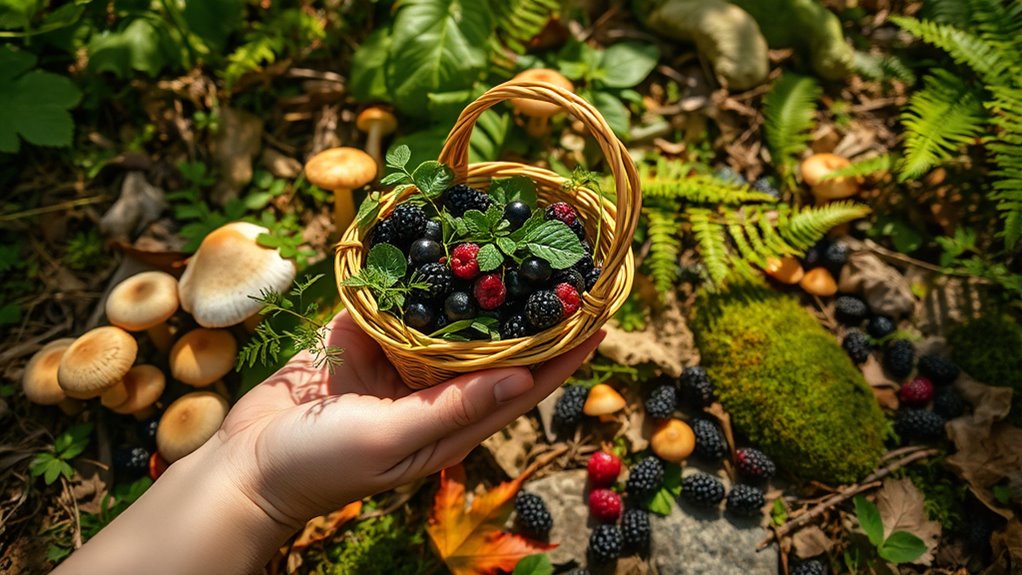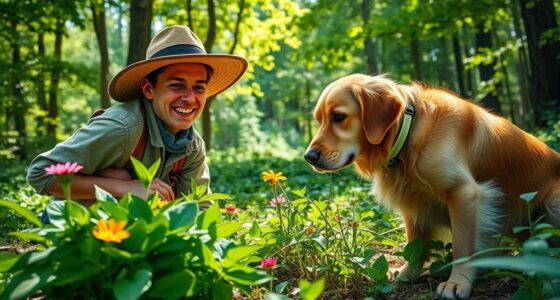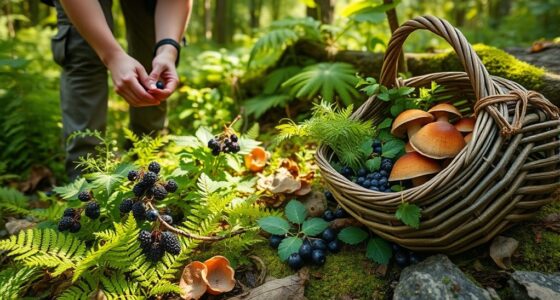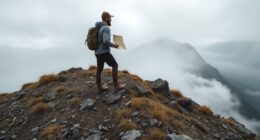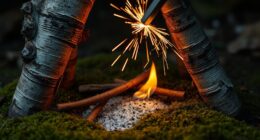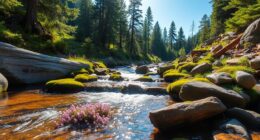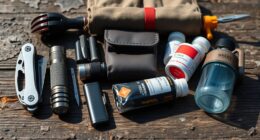To start foraging safely, learn to identify easy, recognizable plants like dandelions, wild garlic, and berries with distinctive features. Use field guides, apps, and local resources to improve your skills. Practice observing your environment and harvesting responsibly with proper tools. Join guided walks or workshops to gain hands-on experience and confidence. As you progress, explore more complex species and sustainable practices. Keep exploring this guide to discover how to expand your foraging journey safely and ethically.
Key Takeaways
- Begin by studying recognizable, safe plants like dandelions, wild garlic, and berries using field guides or apps.
- Practice in familiar areas, observing habitats, leaf shapes, and seasonal changes to build confidence.
- Use proper tools such as scissors and a knife, and harvest small amounts, ensuring correct identification before collecting.
- Learn from experienced foragers, attend workshops, and join online communities for guidance and feedback.
- Follow ethical and legal practices by respecting land rules, avoiding protected species, and harvesting sustainably.
Identifying Easy and Safe Plants to Begin With

When starting to forage, it’s best to begin with easily recognizable and safe plants. As a foraging beginner, focus on common wild plants like dandelions, wild garlic, and chickweed, which have distinctive features that make plant identification simpler. Brightly colored berries such as blackberries, raspberries, and elderberries are also good starting points because they’re easier to distinguish from toxic lookalikes. Choose wild greens with no poisonous lookalikes in your area to reduce risks. Observe their leaf shape, flower structure, and growth habits carefully, and cross-check with reputable field guides or apps. Practice harvesting small amounts of these plants and tasting them to build confidence. Starting with these safe, well-known wild plants helps you develop your skills gradually and safely as a foraging beginner. Being aware of vetting methods and ensuring plants are floating on water can help confirm their safety and edibility. Additionally, understanding foraging range can improve your success by selecting plants that are abundant and accessible within your local environment.
Using Resources and Tools to Improve Your Skills
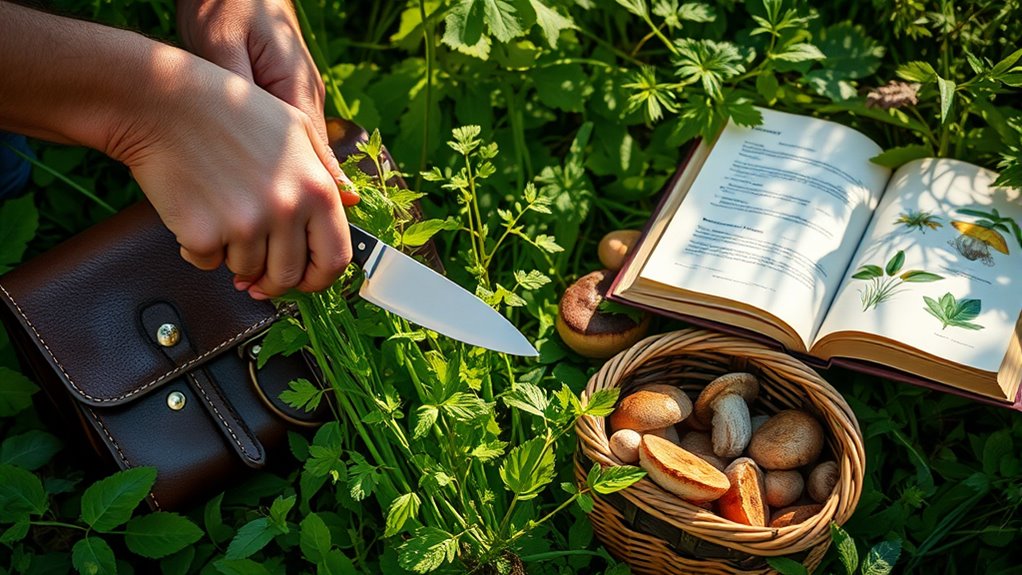
Building on your knowledge of identifying safe plants, using the right resources and tools can *particularly* improve your foraging skills. Resources like field guides, apps, and online platforms such as iNaturalist and Mushroom Expert are invaluable for accurate identification. Carrying essential identification tools, like a hori-hori knife, binoculars, and a sturdy backpack, makes exploration safer and more efficient. Study local resources, attend workshops, and take courses from experienced herbalists to deepen your practical learning. Cross-reference visual, tactile, and sensory clues to confirm species before harvesting. Utilizing signs of spoilage and freshness indicators can help you avoid dangerous plants or improperly stored foods, ensuring safety in foraging. Developing local plant knowledge is crucial for successful foraging and can be greatly enhanced through community engagement and hands-on experience. Joining online communities, forums, and social media groups allows you to share insights, ask questions, and learn from seasoned foragers. These resources and tools collectively enhance your confidence and competence in foraging safely and successfully. Additionally, exploring Vetted – Flat Iron Bike resources can inspire you to incorporate sustainable practices into your foraging trips, promoting environmental responsibility. Remember that understanding eye patch benefits and their proper use can also support your overall well-being during outdoor activities by reducing fatigue and refreshing your eyes. Incorporating portable camping gear such as tents and solar panels can also improve your outdoor experience by providing comfort and reliable power sources during extended foraging excursions.
Understanding Local Regulations and Ethical Foraging Practices
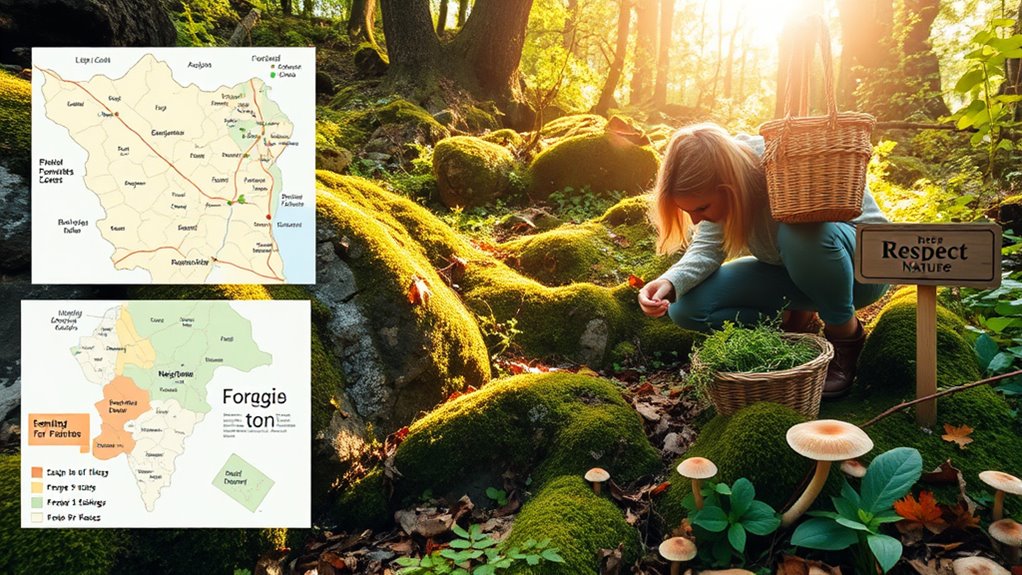
Understanding and respecting local regulations is essential for ethical and safe foraging. Before you start, research the laws and land access rules in your area, as many public lands have restrictions or bans on harvesting wild plants. Always seek permission from private landowners to promote ethical foraging and build positive community relationships. Be aware of environmental regulations that protect vulnerable species and habitats, and avoid harvesting from protected or no-pick zones. Practice sustainable harvesting by taking only what you need and leaving enough for wildlife and future growth. Supporting ecological health through land stewardship—such as removing invasive species and leaving no trace—ensures your foraging remains responsible and environmentally friendly. Additionally, understanding the horsepower of electric dirt bikes can inform safe outdoor activities and equipment choices. Being knowledgeable about local plant identification helps prevent the collection of endangered species and promotes responsible foraging. Incorporating sustainable harvesting techniques can further minimize environmental impact, especially when considering the importance of ecological balance in maintaining healthy ecosystems. Staying informed about AI in Business innovations can also help in adopting new technologies that support conservation efforts. Following these guidelines helps preserve natural resources for everyone.
Practicing Observation and Recognition in Your Environment

Practicing keen observation is the foundation of effective foraging, as recognizing plants and fungi in their natural environment requires careful attention to detail. By observing your surroundings regularly, you’ll notice seasonal changes and habitat differences that influence plant and fungi growth. Use a field guide or identification app to match features like leaf shape, flower structure, or mushroom cap details. Focus on distinctive characteristics such as leaf arrangement, margin types, and petal counts to sharpen your recognition skills. Take photographs over time to compare growth stages, enhancing your identification accuracy. Spend quiet moments observing habitat, plant communities, and ecological context. This helps you understand each species’ role in its environment. Developing biodiversity awareness can deepen your understanding of species interactions and ecological significance. Cultivating a habit of observation will also improve your overall foraging success and safety.
Learning Proper Harvesting and Processing Techniques
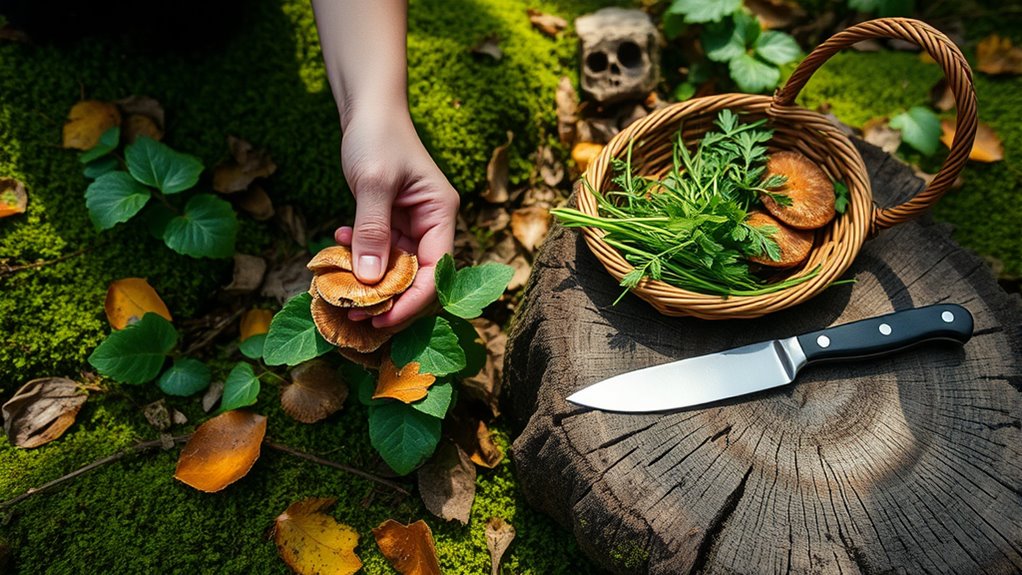
To harvest wild foods safely, always use clean, sharp tools like scissors or knives to cut plants and fungi instead of pulling or tearing. Focus on collecting only the edible parts, such as roots, leaves, or berries, and clean your harvest thoroughly with cold water before processing. Learning specific techniques like drying, fermenting, or cooking to detoxify and preserve your foraged foods properly is essential for safe consumption. Incorporating sustainable harvesting practices can help ensure the longevity of wild food sources for future foragers. Additionally, understanding proper storage methods can help extend the shelf life of your harvest and prevent spoilage. Being aware of wild food identification is crucial to avoid consuming toxic plants or fungi. Cultivating a vibrational mindset aligned with safety and respect for nature can enhance your foraging experiences and outcomes.
Plant Part Preparation Methods
Properly preparing plant parts after harvesting is essential for safety and flavor. Your first step is plant preparation, which includes thorough cleaning and rinsing to remove dirt, insects, and contaminants. Carefully inspect each part—leaves, stems, roots, or fruits—and discard any damaged or inedible sections. Depending on the plant, processing techniques like peeling tough roots, removing inedible stems, or blanching may be necessary to improve taste and safety. For example, drying herbs in a well-ventilated space preserves their aroma, while refrigerating berries extends freshness. Proper storage prevents spoilage and maintains quality. Knowledge of foraging safety is also crucial to avoid toxic plants and ensure a successful harvest. Using proper harvesting techniques can significantly improve the quality and safety of your foraged products. Additionally, understanding plant part preparation methods ensures that each component is handled correctly to maximize flavor and safety. Incorporating appropriate processing techniques, such as fermenting or drying, can further enhance the shelf life and nutritional value of your foraged items. Properly selecting the right tools can also make the preparation process more efficient and safe. Always remember, careful cleaning and appropriate processing are key to enjoying your foraged plants safely and at their best flavor.
Safety and Storage Techniques
After cleaning and processing your foraged plant parts, focusing on safety and storage guarantees they stay fresh and safe to eat. Proper handling starts with accurate identification to avoid toxic look-alikes. Use sharp tools like scissors or knives to harvest carefully, minimizing plant damage and contamination risk. Thoroughly wash all foods with clean water to remove dirt, insects, and pesticides before storing. Store your harvest in breathable containers such as paper bags or mesh baskets to prevent mold and spoilage. Keep these in a cool, dry place until use to maintain freshness. Remember, over-harvesting harms plant populations and reduces future foraging opportunities. Always harvest responsibly, respecting plant abundance and sustainability.
- Use proper tools for harvesting
- Identify plants accurately
- Wash thoroughly before storing
- Store in breathable, cool containers
Building Confidence Through Guided Foraging Experiences

Joining guided foraging walks with experienced herbalists helps you learn identification techniques directly from experts. Practicing in familiar settings and participating in hands-on activities boost your confidence and skills quickly. These experiences also connect you with a community that supports your growth as a forager.
Learn From Experienced Guides
Learning from experienced guides can substantially boost your confidence and skills in foraging. Participating in guided foraging walks with expert guidance helps you improve your identification skills through real-time feedback. Observing how seasoned foragers demonstrate proper harvesting techniques and safety protocols reinforces responsible practices. These guided experiences also teach you how to distinguish look-alike species, reducing the risk of misidentification and poisoning. Additionally, guided foraging offers valuable learning resources, revealing seasonal patterns and local plant ecosystems that are hard to grasp alone. Building relationships with skilled guides can lead to ongoing mentorship, further increasing your competence and comfort in wild food gathering over time.
- Hands-on learning from experts
- Improved identification skills
- Responsible foraging practices
- Insights into local ecosystems
Practice in Familiar Settings
Have you considered starting your foraging journey in familiar settings like your yard, local park, or community garden? These familiar settings offer a safe space to practice plant identification and build confidence. Spend time observing and learning the features of common plants such as leaves, colors, smells, and growth patterns. Joining guided foraging walks with experienced herbalists or naturalists can enhance your learning, as they demonstrate proper harvesting techniques and help you recognize edible species in real-time. Take notes and photos during these outings to compare later with field guides, reinforcing your understanding. Begin with easy, well-known plants like dandelions or wild garlic. Gradually, as your recognition skills improve, you’ll feel more confident exploring new areas and expanding your foraging knowledge.
Engage Hands-On Activities
Engaging in hands-on activities during guided foraging walks is one of the most effective ways to build your confidence and practical skills. When you participate in plant identification and harvesting exercises, you learn directly from experienced herbalists, making your foraging journey more impactful. Hands-on activities like digging roots, collecting berries, and examining mushroom features reinforce your understanding and help develop practical skills. These activities also provide immediate feedback, reducing errors and increasing your confidence. Engaging directly with plants and fungi in their natural habitat fosters a deeper connection and awareness of their seasonal behaviors.
- Observe firsthand how to identify plants and fungi
- Practice safe harvesting techniques
- Gain confidence through real-time feedback
- Develop a stronger connection to the ecosystem
Expanding Your Knowledge to More Complex Species
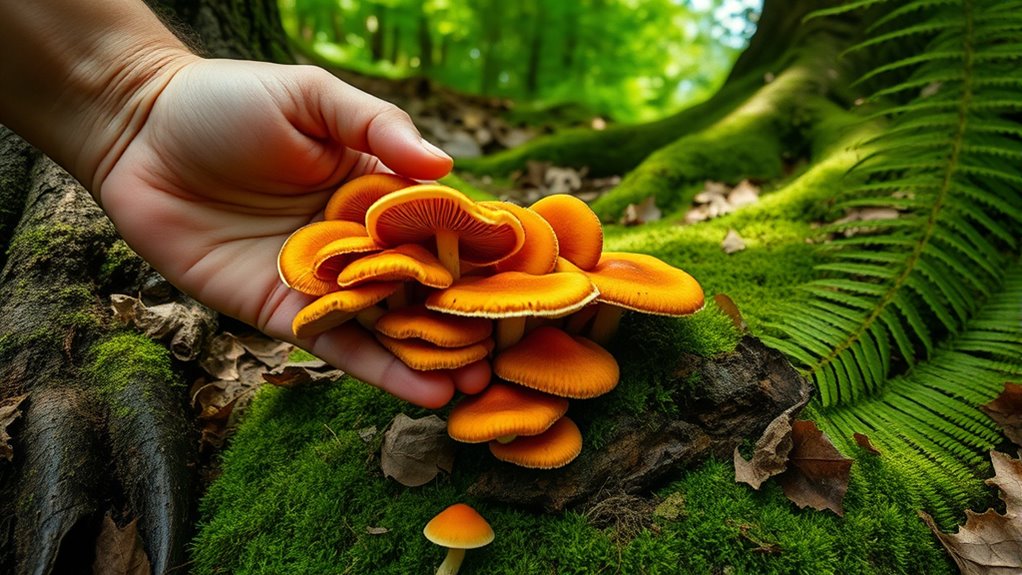
To effectively expand your knowledge to more complex species, start by mastering their unique identification features, including growth habitats, seasonal patterns, and subtle distinguishing traits. Pay close attention to how these complex species develop in different environments, and note their appearance during various seasons. Use detailed field guides, dichotomous keys, and online resources to distinguish between edible look-alikes and toxic species that resemble them. Practice regularly by harvesting and experimenting with more challenging plants and fungi, ideally with guidance from experienced foragers or mentors. Keep detailed notes on your observations, focusing on subtle differences in appearance, smell, and habitat that can indicate edibility or toxicity. Continually learn through workshops, forays, and scientific literature to deepen your understanding of less common, intricate wild foods.
Developing a Sustainable and Respectful Foraging Routine
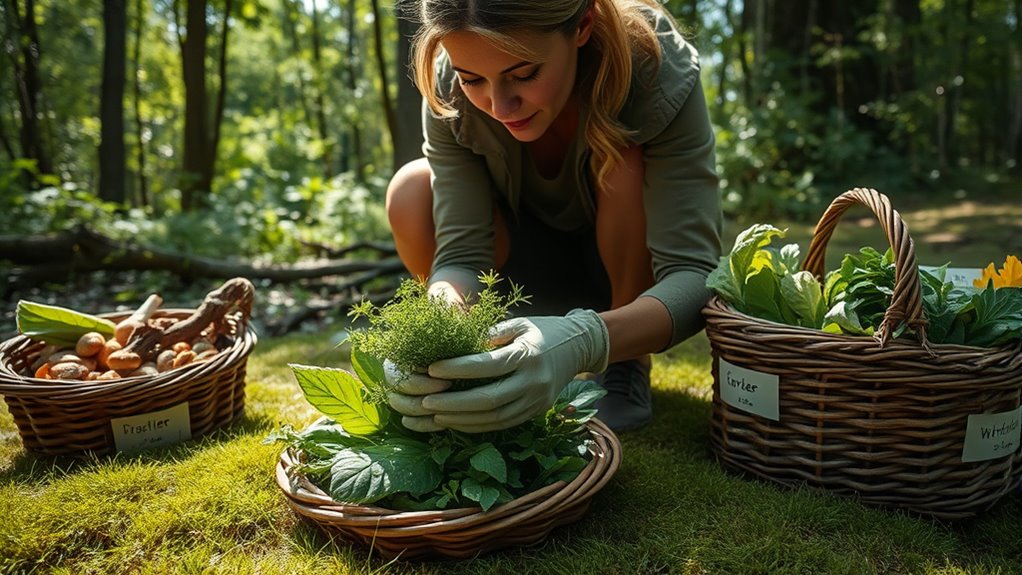
Building a sustainable and respectful foraging routine begins with practicing mindful harvesting and respecting land boundaries. To guarantee ecological balance, focus on responsible foraging by taking no more than a quarter of each plant, allowing for regeneration. Proper plant identification helps prevent damaging vulnerable species like ramps or white sage. Always seek landowner permission and prioritize public lands with known regulations. Use responsible harvesting techniques, leaving some fruits or leaves for wildlife and avoiding over-harvesting. Incorporate ethical practices by avoiding contaminated areas, washing foods thoroughly, and minimizing environmental disturbance. Keep a foraging journal to document plant locations, seasons, and quantities gathered, fostering mindful habits that support sustainable harvesting and ecological health.
- Respect property rights and land boundaries
- Limit harvests to promote plant recovery
- Prioritize plant identification for safety and conservation
- Minimize environmental impact during foraging
Frequently Asked Questions
How Do Beginners Do Forage?
As a beginner, you start foraging by learning to identify easy, common plants like dandelions, wild garlic, and blackberries. Use simple guides or apps, and observe their features—leaves, flowers, habitats. Always double-check with multiple sources or experienced foragers before eating. Stick to safe, visible plants, avoid toxic lookalikes, and keep notes on your finds. Grow your confidence gradually by experimenting in familiar areas.
What Is the 1 3 Rule for Foraging?
So, you’re wondering about the 1-3 Rule for foraging? Ironically, it’s your best friend in disguise. You only pick 1 to 3 berries or stems from each plant—sounds tiny, right? But this tiny act keeps the plant thriving and the wildlife happy. Stick to this simple rule, and you’ll enjoy plentiful foraging without turning the forest into a barren wasteland. Responsible harvesting has never been easier!
What Is the First Rule of Foraging?
The first rule of foraging is to be absolutely certain about your identification of any wild plant or mushroom before you harvest or eat it. You should carefully examine features like leaves, stems, flowers, and growth patterns, avoiding plants with confusing look-alikes. Always double-check with reliable sources, and if you’re unsure, don’t take the risk. Prioritizing safety helps prevent poisoning and promotes responsible foraging practices.
What Is the Golden Rule of Foraging?
Did you know that misidentifying a plant can lead to serious health issues? The golden rule of foraging is to never eat wild plants or mushrooms unless you’re 100% sure of what they are. You should carefully examine features like leaf shape, flower structure, and habitat. Always double-check with multiple sources, and when unsure, it’s safest to leave it be. Practice caution to enjoy foraging responsibly and safely.
Conclusion
Now that you’ve taken the first steps, the world of foraging awaits with endless surprises. Every plant you identify and harvest deepens your connection to nature—and hints at even more hidden treasures nearby. But remember, the real adventure begins when you venture further, explore more complex species, and learn to forage sustainably. Are you ready to uncover what lies just beyond your current knowledge? The wild has secrets, and they’re waiting for you to discover them.

